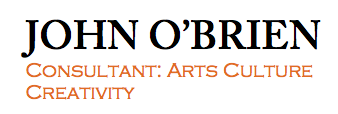I said on social media when this lock-in started that I would post some big picture ideas on arts and culture practice, policy and economics, so here’s the first in a series of what I hope will be useful provocations.
Direct government funding to the arts in this country cannot – and most probably never will – meet the EU average of 0.6% of GDP (regardless of whatever remarkable “changes” are expected after the Great Lock-In) We need to accept that and stop making it the central ask of lobbying efforts. Here’s why
There’s an argument doing the rounds that every euro invested by the state in the arts returns two euro to the state. So what’s the problem? Just keep giving the arts whatever they need! This argument is based on a misunderstanding of the economic “multiplier”.
How does the multiplier work: essentially, I receive €10 from the state; I spend all that €10 on artist fees, materials etc; the state reclaim an amount in tax (lets say 40%). the remaining €6 is spent (on coffee, sandwiches, rent etc) generating €2.40 in tax; the remaining €3.80 is spent (on staff and supplies in the local coffee shop) and the state reclaims another €1.50 and so on. So in the this example the original €10 of state investment has produced €19.80 in direct, indirect and induced spending (10+6+3.80) and returned €7.90 (4+2.40+1.50) to the state. And that, in essence, is the multiplier effect.
This multiplier is calculated differently in different reports. The Indecon Report on the impact of arts funding (2010/11) set the multiplier at 1.28, however the Olsberg Report on the audiovisual sector in 2017 set it at 2.19. The Olsberg report also claims (citing Department of Finance sources) that for every euro in circulation 40% returns to the state in direct and indirect taxation. So, let’s take the Olsberg Multiplier and apply it to the current Arts Council funding and see if it returns €2 for every €1 invested.
And very obviously it doesn’t. And when you increase it three fold, the state looses close to €30 million. So how do we get to this idea of every euro of state money bringing back two euro in tax?
The arts and cultural economy has many strands of income. The analysis of arts council clients conducted by Indecon (2010/11) reckoned that the turnover of each client was composed of state funding (45%) and other sources (65%) such as sales, sponsorship, patronage, etc. In other words the state funding attracts additional money. What happens when we factor that additional money into the above table?
And voila – now the state collects over €2 for every €1 it invests. So surely then, if the state invested 3 times what they invest the arts council investment ALONE would generate almost €274 million in tax! Except of course, it wouldn’t; because for that to happen the additional money – the sales, the patronage, the sponsorship – would all have to increase by a factor of three as well.
We know from various reports conducted by 2into3 that patronage and sponsorship in the arts is negligible and extremely sensitive to wider economic fluctuations, so most of that additional money is personal disposable income, therefore personal disposable income would need to increase 3 fold. If that does not happen (which it won’t) then any increase in arts funding looks like this:
A three fold increase in funding (€240m) results in a €20 million LOSS of tax revenue, compared to the return on the original investment (€80m).
Therefore, within our economy as it is currently structured, increasing funding to the arts only makes sense if we can guarantee that people’s disposable income will also increase – this means pay increases across the public and private sector, significant increases in the minimum wage, rent freezes, house price controls etc. etc. NONE of which will happen without significant political upheaval and certainly not in the short term.
So the problem that needs to be addressed is how can we stimulate the flow of personal disposable income into the sector given pay stagnation, rising housing, insurance, and childcare costs etc., so that it increases in tandem with state funding? The only answer is tax incentives. So – big idea number one 1: STOP ASKING THE STATE FOR MORE DIRECT FUNDING – IT CAN’T GIVE IT.
Instead, look to stimulate the flow of personal disposable income through tax incentives. Give us equality of treatment and opportunity with the so called commercial sector.
Oh – and at the same time lobby for wage increases, rent and housing price control, single tier public health, free education and child care – because if we are not giving between a half and a three quarters of our income in rent, if we’re not paying exorbitant childcare and healthcare, if we’re not paying what are now the highest 3rd level fees in Europe, sure we might be paying more in tax, but we will have more disposable income.




Makes the kind of analysis that so many in the arts shy away from. More analysis is always needed when the business of funding is business.
LikeLike
Governments fund many things that make no such financial return. Let’s change the politic and stop treating public access to art as if it were commerce.. In the north I’d say … health, defence art.; where’s the National Arts Service ?
LikeLike